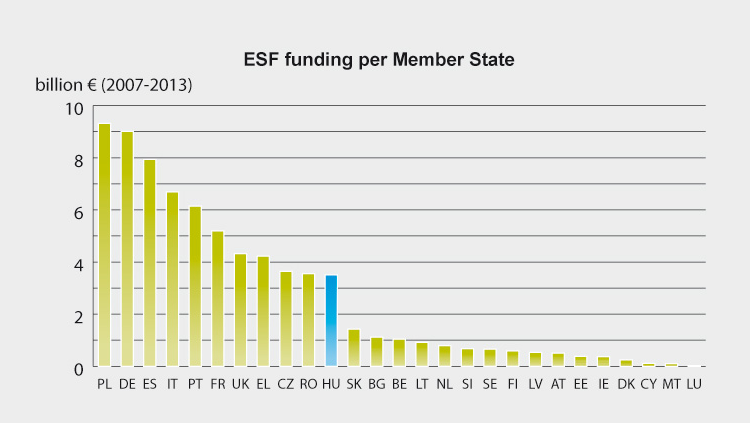Structural and cohesion funds represent more than a third of the EU’s budget. We will only be able to assess their importance if we are aware of the economic situation of member states. The volume of our region’s share has more than doubled since 2007 – over half of the total funds have been earmarked for the CEE countries. It is encouraging because CEE countries are the less developed ones in the European Union. According to a 2009 research, the 20 poorest regions of Europe are in Poland, Romania, Bulgaria and Hungary– dispersion of GDP per capita in these regions is between the 25-42 percent of EU’s average. Obviously, these countries need financial support to develop their infrastructure, education, enterprises, or gain recourses for new technologies. For this reason, there is no need to cut redistribution programs, but it is urgent to optimize their effectiveness.
In the past few years, tendencies show that one new member state has started to drop back from the others: Hungary – with a GDP of less than 75 percent of the EU average – was severely hit by the crisis in 2008, when the country lost access to market-based financing. To overcome these difficulties,Hungaryimplemented an adjustment program that focused on fiscal consolidation and financial sector supervision, and was supported by financial assistance from the EU and the IMF. Against this background, the country regained market access in 2009, and the economy emerged from recession for a short period. Even so, Hungarian economy has barely increased since the accession: GDP is at the same level as it was in 2005.
Hungary closed the year 2012 with a series of negative outcomes. Inflation, restrictions, new taxes, wage-cuts, less jobs and more nationalization: these words describe last year in Hungary. Poverty and related factors such as joblessness or low education levels continue to affect not only some disadvantaged groups (particularly the Roma), but the middle class.Hungary’s situation is disquieting, because it is known that most of the other countries in the region are developing faster: for instance, in Slovakia and Poland GDP is increasing. As we can see on the graph, in the past few years Hungary’s share in the European Social Founds was significantly greater than Slovakia’s. What does it all mean? Is the importance of these funds trivial with respect to development? We cannot state that. All we know is that the importance of the structural and cohesion funds is much bigger for Hungary than for the others in CEE, because there is no other way for this country to escape from the poor situation without these funds.
Source: ec.europa.eu
Fight for the Euros or fight with the EU?
According to the European Commission, the member states will access the Unionresources in 2013 more easily, because rules are being simplified, thereby the system will be more transparent and more effective. It is good news, butHungaryhas other problems: on the one hand, the effective utilization of the resources is obstructed; on the other, the access is made more difficult by its own government.Hungaryis called sometimes the “black sheep” because of its government’s problematical relationship with the EU. From some points of view, the direct relationship between the Commission and the regions cuts out the legitimate role of national governments. The European Commission is dissatisfied with Hungary’s efficiency, and wants to have more influence on the government’s actions. Nevertheless, the Prime Minister, Viktor Orbán, stands up for his views and arguments, due to the infringement procedures against the country accumulating continuously. Besides, Hungary has been subject to an excessive deficit procedure since 2004, because the budget deficit has been beyond 3 percent since then. Against this background, focusing on this skirmish is the wrong direction, because the problems will not evaporate. The process that takes place there now is such that it was put forward that structural funds for the country be stopped. Over and above, it is expected that Hungary will get 30 percent less cohesion funds in the next financial period of the EU (2014-2020), because the amount of support will be adjusted to economic growth, which is extremely low in Hungary (0,8 percent). Is it really worth fighting with the EU, instead of coming to an optimal arrangement with them?
Does Hungary have another chance?
There are many questions to answer in this matter, but it is obvious that Hungary’s fortunes are not on the rise and there is no other or better assistance Hungary could count on. Well aware of this, it is worth fighting for Euros on more scores than one. First of all, the purposeful funds need to serve the improvement of competitiveness to help compensate the effects of joining a single market. Besides, a real advantage of the funds is that, instead of simply giving money to national governments, structural funds focus on the needy areas directly. Catching-up will only be available for new member states if financial support is used for those drawbacks which are standing in the way of development. Finally, the funds have to facilitate procreating a more organic and integrated continent, which is the elemental goal of the European Union.
According to the Hungarian liberal view, a more intense cooperation is the key to a more competitive Europe. Increased integration with more poor regions will mean that the distribution of funds will be unsustainable and poor regions will lose out. The only option to achieve the most important goal is the external financial assistance for new and underprivileged member states. The process of close-up has not been completed yet, but there are already visible signs of its positive effects so it has to carry on. As the old saying goes: the old, rich ones must take care of the little, poor ones to build something good together.




















No comments
Be the first one to leave a comment.